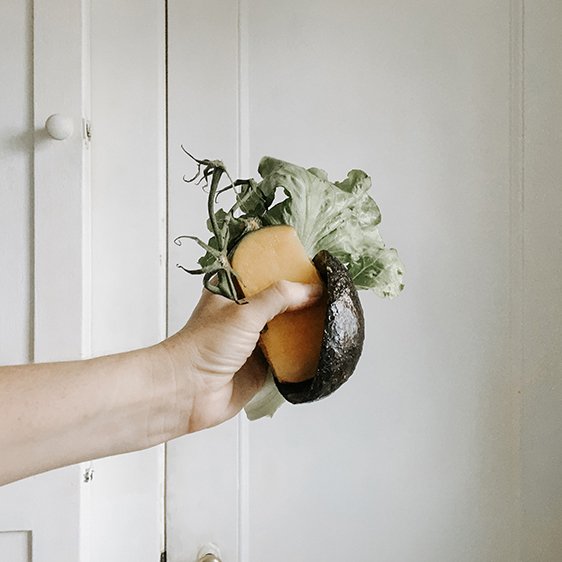17 Easy Sustainable Home Building Tips For Everyday Homes
Building or renovating a house and looking for easy, sustainable home building ideas no matter what type of house you’re building or renovating? Check out this list for some affordable eco-friendly home tips to save you money and help your home be a little kinder to the planet.
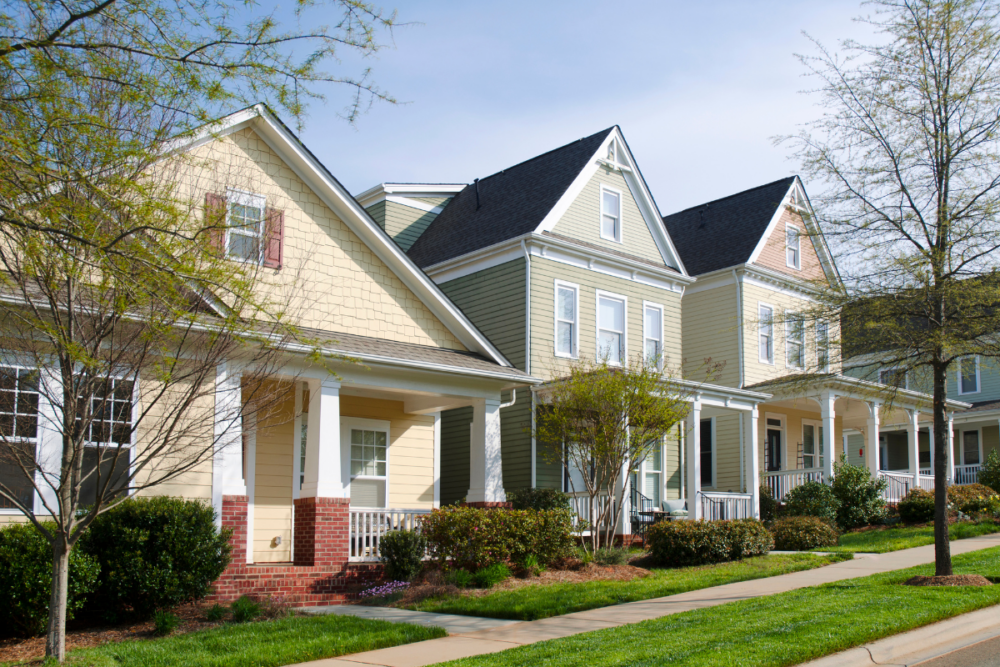
I have two siblings (my sister and my husband’s brother – and their respective spouses) who just happen to be building new homes right now. As I watch them build their homes, they sometimes come to us with questions about home building suggestions based on our own experiences. They ask others too; they’re just gathering perspectives. I’m certainly not the construction guru.
But during these discussions, I can’t help but see their experience through my “green-colored glasses” and offer ideas about options they can choose to make their respective homes more sustainable, often at little to no extra cost.
We purchased our house and did significant renovations before we moved in many years ago (and before I really understood many of the more sustainable home building options available to me). Over time, we have made some subsequent changes that are more eco-friendly. But a lot of the investments made upfront are much harder or more expensive to change later than just making the better choice from the beginning.
My sister and her husband are building a new house with an architect on a plot of land they purchased in the Pacific Northwest. My brother-in-law and his wife, who are building closer to us in the Philadelphia area, chose a pre-designed suburban development, so their choices are somewhat more limited than my sister’s.
But they both still have lots of options and decisions to make about things like heating, lighting, and landscaping, that can have wildly different environmental impacts and help fight climate change without changing their initial budget much. And even better, many of the more sustainable options are much less expensive in the long run.
Unfortunately, it seems like many builders don’t really know about sustainable home building alternatives (or at least don’t default to more sustainable options) unless sustainability is part of their brand. I’m sure many of the builders and contractors choose options that are more familiar to them and more easily accessible (which I totally get), so we often have to ask specifically for some of the more sustainable home building alternatives.
Last week, my sister was asking me some questions about sustainable water heaters and HVAC systems. Instead of writing her a long email, I thought it might be helpful to share my ideas on sustainable home building options too. Maybe someone else can benefit from a few of them as well.
Through a round of significant home renovations when we first purchased our home, a second round of construction work adding an addition to our home, and then doing a few smaller renovations, we’ve been working with general contractors on and off for nearly seven years. I’ve learned about many different sustainable home building ideas that run the gamut regarding effectiveness and affordability. Some are super easy to implement and well worth the investment. Others are much more expensive or require some serious planning (even though they often yield great results when done properly).
17 Easy Sustainable Home Building Tips For Everyday Homes
I know my sister and brother-in-law and their spouses aren’t in a place right now where they will hire green home builders and build some futuristic or perfectly sustainable house (if such a thing even exists). But there are lots of things they can do during their initial home builds that won’t break the bank or violate their HOA rules while still being better options for the planet.
When doing some research for them, I came across lots of sustainable building tips that were great – things like natural materials consideration, pre-fab homes, incorporating a green roof, and more. These are all really useful ideas, but I was looking for some quick first steps to consider that would feel achievable and accessible even for those who aren’t knee-deep in green living priorities.
With that in mind, here are some easy and affordable sustainable home building tips and ideas that can help make your house more eco-friendly (and often save you money long-term). It’s far from an exhaustive list, but hopefully, it gives you ideas of places to start incorporating more sustainable home building elements into your house.

Eco-conscious Home Design and Layout
To the extent you’re able, eco-conscious home design starts from the very beginning. In many cases, the sooner you prioritize sustainability, the larger the impact you can have and the more affordable those investments become.
The ship might have sailed on these sustainable home building considerations if you’re already past the design phase, are working within the confines of a pre-designed development, or are doing renovations on an existing home to make it your own. But if you’re early in the process and have flexibility, some of these ideas could have major impacts on the efficiency of your home and reduce the costs and the carbon footprint all along the way.
Home Sizing – Smaller is Better!
McMansions anyone?! This isn’t a quick swap, but it is such a huge aspect of sustainable home building that it couldn’t be left unsaid. We live in a world where bigger is often assumed to be better, but the absolute MOST sustainable thing you can do when it comes to building a home is choosing a layout and square footage that are not too big. When it comes to housing efficiency and environmental impact, smaller is better.
A larger home means more materials and energy to build it, more furniture to fill it, more chemicals and energy to clean and maintain it, more energy used to heat and light it, etc… Just more of everything (and the demand for more of everything that requires resource consumption is the underlying issue at the heart of our planetary woes). During the design process, remember that smaller is better for your bank account and the planet.
Add Extra South-Facing Windows for Natural Light
Consider the location of your home in relation to the sun. By placing windows and openings on the southern side of the house, you can take advantage of passive solar design (i.e. making the most of the heating and natural light from the sun) and reduce energy use.
This layout enables your home to naturally warm up during the day and stay cooler in the evening, ultimately reducing your reliance on fossil fuels for heating and air conditioning. You also get all the benefits of natural light bursting into your home and can save money by using less electricity for artificial lighting.
If you live in a warmer climate or are concerned about too much heat in the summer months, strategically placed deciduous trees can help manage this light throughout different seasons. Leaves in the summer will create shade over those south-facing windows to limit passive solar heating while the lack of leaves in winter lets in all the sunlight to heat up your home with less energy.
The above circumstances apply to homes in the Northern Hemisphere. If you live south of the equator, the same strategies can apply to north-facing windows.

Energy Efficient Home Fundamentals
HVAC (Heating, Ventilation, and Air Conditioning)
Your HVAC system will likely be the largest user of energy in your home (at least it is for us, by a long shot). Electric heat pumps are the most energy-efficient way to heat and cool your home. I’ve also read that they manage temperatures more effectively than many fossil-fuel-powered HVAC systems.
We transitioned from an oil-powered furnace to an air source heat pump a few years ago, and the difference in comfort levels of our home was like night and day. So if our experience is any indication, I agree that a heat pump is not only better for the planet but also gives you a better experience in your home.
HVAC systems get pretty complex quickly, so check out the Electrify Everything in Your Home Guide from Rewiring America for a breakdown of all the things to know about heat pumps. The guide includes what to know, how to prepare for an installation, what investment to expect, what questions to ask your contractor, and more. You’ll need to enter your email address to download it for free, but it’s well worth the exchange!

Programmable or Smart Thermostat
Programmable thermostats are pretty inexpensive in the grand scheme of heating and cooling your home. We have had a couple of different brands over the years. We used to have a Nest (which I didn’t totally love), and now we have a Carrier thermostat that goes along with our heat pump system (and I really like it).
These thermostats allow you to set different temperatures throughout the day so you can reduce the amount of energy used by your HVAC system. They do the work of making sure your system runs in a way that maximizes efficiency without compromising on comfort. You’re going to buy a thermostat anyway, and a programmable one is not much more expensive but will more than return its value in cost savings over time.
Good Insulation
A well-insulated home can significantly reduce your energy consumption. Insulation helps to maintain a comfortable temperature by reducing heat transfer between the indoors and the outdoors. This means your heating and cooling systems won’t need to work as hard, saving you energy and money.
You should pay special attention to the insulation in your home’s walls as this is a critical aspect of energy efficiency. I’m not an expert on insulation, but if you’re building a new home, be sure to ask your general contractor for recommendations. If it’s in your budget, high-quality insulation likely will be a valuable return on investment, particularly if you live in an area with an extreme heat or cold climate.
Solar Panel Energy
Solar panels convert sunlight into electricity, reducing your reliance on non-renewable energy sources. Many people have rooftop solar panels, though there are stand-alone panels and community solar projects as well. While the upfront investment for solar panels seems daunting, it may not be as much as you expect.
In many cases, the cost to finance solar panel installation is offset by the savings from lower (or no) electricity bills. Particularly if you can add the cost of the solar panels into your mortgage or home loan (if that’s allowed), you might find that it doesn’t actually change your overall cash outflow once you move into the house. Your mortgage payment may be a bit higher but you will have significantly lower utility bills.
Due to their lifespan, solar panel installers generally require (or strongly encourage) solar panels to be installed only on new or nearly new roofs. Installation labor is a big piece of the expense, so it is silly to install the panels only to have to take them down in a few years to replace the roof.
Including solar panels in your new or updated home seems like a big project (and it is), but I’ve included it in this list because financing and large government rebates of up to 30% of the cost make adding solar panels to your home a much more reasonable and achievable sustainable home building adding than they might initially appear.
This Electrify Everything in Your Home Guide from Rewiring America has a ton of really practical information about installing solar panels and considering a home battery to go along with the solar power system.
High-Performance Appliances
Investing in energy-efficient appliances can greatly reduce your energy consumption (and corresponding energy bills). High-performance appliances, such as refrigerators, washing machines, and clothes dryers, use less energy compared to older, less efficient models. Invest in the most efficient options you can afford. That Electrify Everything in Your Home Guide has a section on electric clothes dryers as well.
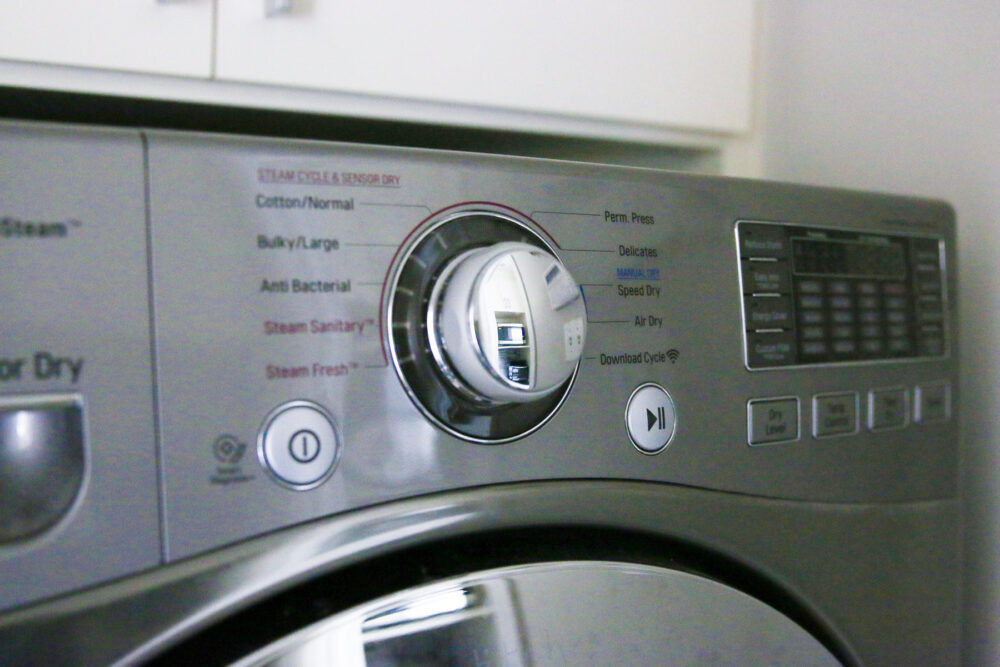
May I also suggest investing in a line dryer for your clothes? I’m a big fan of the Brabantia Rotary Line Dryer. I know it’s a stretch (especially in the United States where line-drying clothes is very out of vogue).
However, the clothes dryer is often the most energy-intensive appliance in the home, so line drying some of your clothes from time to time can help reduce energy usage, save money on your electricity bills, and help your clothes last longer (the dryer can be tough on them). I know most people won’t line dry all of their clothes (we don’t), but you might actually like it sometimes if you give it a fair shot.

High-Quality Windows & Sheer Blinds
Similarly, high-performance windows with proper glazing can provide excellent insulation, reducing heat transfer and lowering your energy costs. Be sure your windows also lock out any drafts, an easy way to lose so much of the climate-controlled air inside your home.
Sheer blinds are a great option for helping control the natural light and temperature inside your home. If you’re planning to buy window coverings for privacy anyway, sheer blinds let in light while adding an extra layer of insulation. In the winter, they keep cold air out of the house. In the summer, they prevent the sun’s heat from creating too much passive solar energy to warm up the room unnecessarily.
We have these types of blinds and I’m always amazed at the temperature difference inside the blinds compared to the much colder temperature between the blind and the window. Imagine if all that cold air cooled our house in the winter!
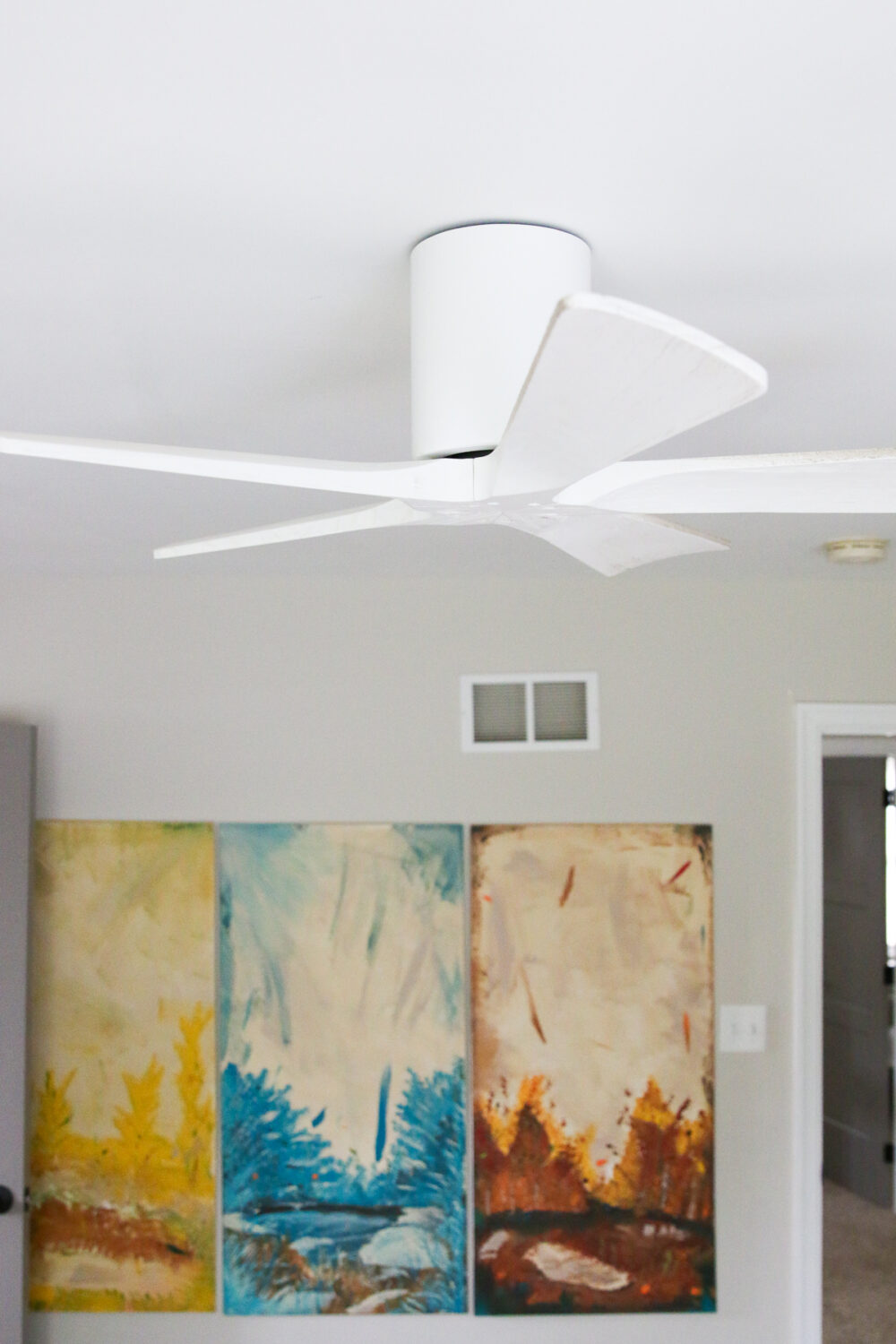
Ceiling Fans
Particularly if you have high ceilings or multiple levels in your home, ceiling fans can really help circulate air throughout your home to best manage a comfortable temperature. Overall, moving air around so the house is one consistent temperature as much as possible will help reduce the need for excess heating or cooling energy.
A couple of years ago, we installed ceiling fans in our upstairs bedrooms. We run them almost all the time (through all seasons) because they make such a difference in keeping temperatures in the same vicinity between the two floors of our home. Not only do they reduce our energy costs but they also help keep the house more comfortable for all of us for far less money than trying to manage temperatures using one or more heat pumps.
Electric Vehicle Charger
If you’re planning to drive an EV, have the electricians install a generic outlet in your home or garage for the EV while they’re building or renovating other areas of your home. It’s much easier for them to do the projects all at once than to come back for something small like an EV charger installation.
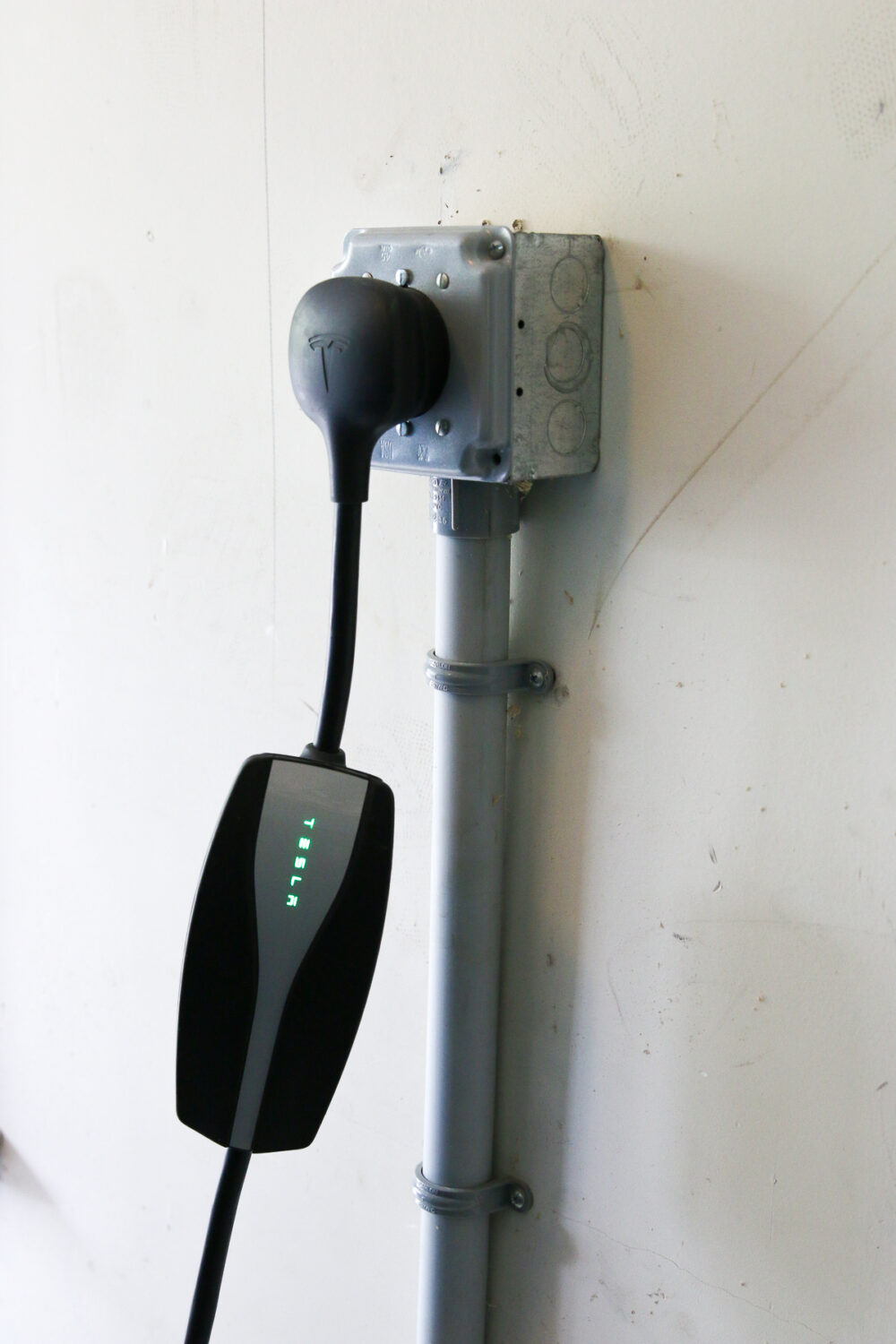
Water Consumption & Conservation
Heat Pump Water Heater or Tankless Water Heater
If you’re choosing a new heater for your home, skip the old tanks. Tankless (or instant water heaters) are better, and heat pump water heaters are even more efficient. We have a tankless water heater which essentially means it heats water as we need so there are not tanks sitting full of water to be continually heated (and we never run out of hot water). It was a great upgrade we made to our home (which had a pretty small hot water heater when we moved in).
I’ve been hearing more about heat pump water heaters as the next thing in efficient water heating technology. While it still requires space for a storage tank, they keep the water hot with even less water than a tankless hot water heater (and can help you avoid higher time-of-use energy rates if you have those available to you).
You know where I’m going to send you to get more information, right? Yep! That Electrify Everything in Your Home Guide. They’ve done so much of the leg work to walk you through the process and explain the options, that it’s silly not to just go directly to the source!
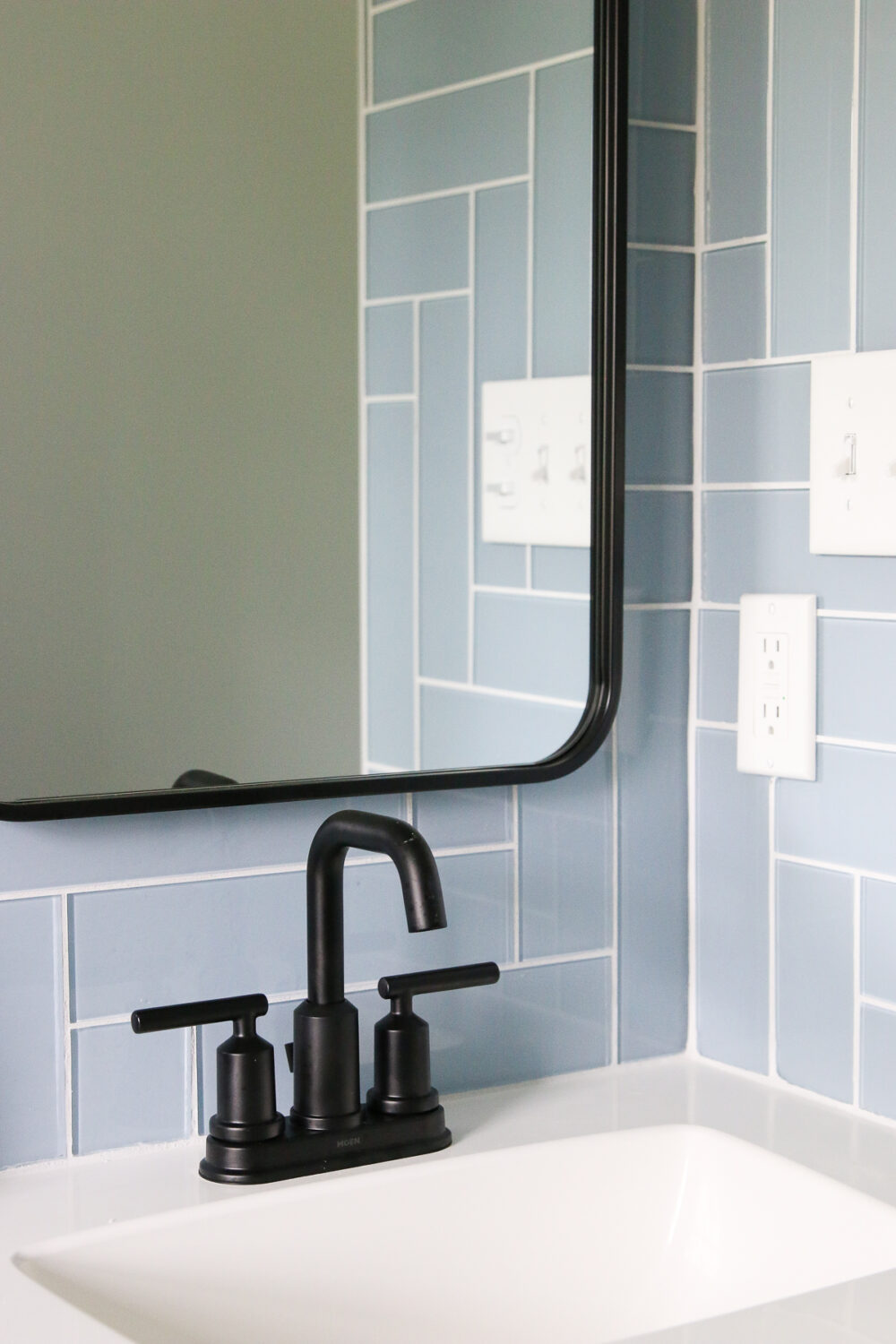
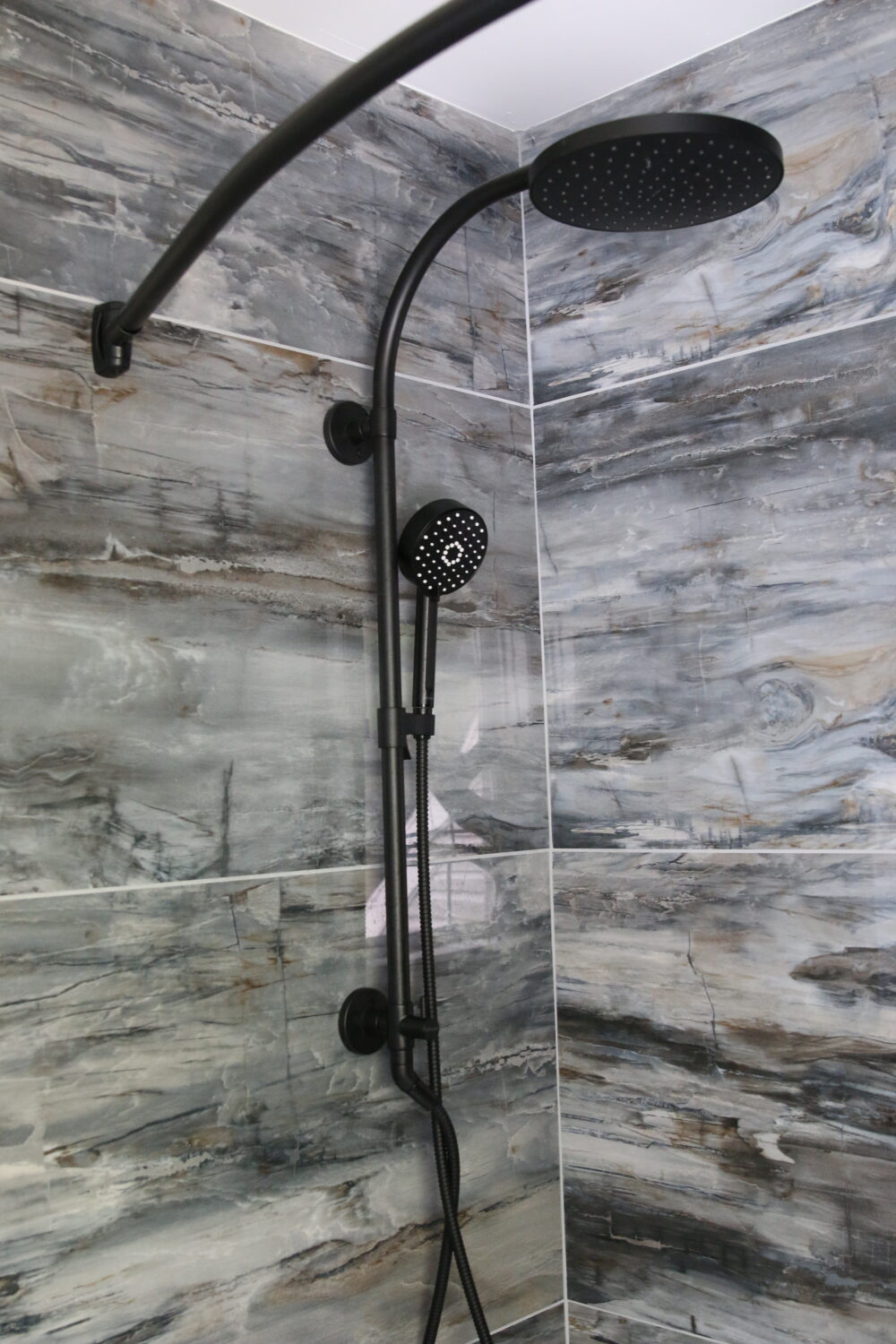
Low Flow Faucets & Showerheads
Many showerheads and faucets meet low-flow standards these days, but be sure to choose something that has these criteria before falling in love with that perfect bathroom hardware. Low-flow water appliances have sufficient aeration now that you can get less water usage without sacrificing comfortable water pressure.
Reduce Construction Waste
The giant bin outside any construction site is evidence alone of the vast amount of construction waste produced from any building or renovation project. During both of our projects, we’ve had that large rollaway trash bin sitting in our driveway for weeks (or months), and I cringe every time I think about how much waste went into the hauler. But for all of our projects, we were able to limit some of the waste from our construction work.
Sell or Give Away Materials Online
Facebook Marketplace, our local Buy Nothing group, and even the workers themselves helped me rehome many of the really large items of waste we might have otherwise tossed in the trash. I was also really clear upfront with the general contractor and project manager that I wanted to make sure as much material was suitable for reuse as possible (an important thing to tell them before demolition if you’re doing renovations).
When we renovated our kitchen and bathroom, workers took all the cabinets and the bathtub for use in their own projects at no cost. I was happy not to throw the items away, and they had the skills to install these items in their own homes or for friends.
When we renovated our second bathroom, I posted the cabinets on Facebook Marketplace for free, and they were picked up in less than 48 hours. I also gave away smaller things like the shower curtain and rings.
I even offered up our trampoline (that our boys no longer use) to the professional tree clean-up team when they came to remove many of the trees that fell in our yard due to a large storm. One of the guys took the trampoline home for his kids. I was thrilled it found a new home. I didn’t have to worry about breaking it down and putting it in the trash. And their family got a new-to-them trampoline that I hope they love as much as my kids did when they were younger.
Buy Materials Secondhand
There are also lots of options to buy some of the materials you need secondhand. A while back, my neighbor found a great granite countertop for her kitchen on Facebook Marketplace. She saved so much money and kept that countertop out of the landfill. You can source all sorts of materials online or even at places like the Habitat ReStore.

Sustainable Landscaping and Outdoor Strategies
Ditch the Manicured Lawn
First things first when it comes to your yard, ditch the unused manicured lawn. There are so many better and more beautiful options that are also much better for the ecosystem and your community. If you use your lawn as a play space, keep that part for your family. We have a large front yard that we use for playing all sorts of sports.
As you settle into the house, you may want to consider what you put on that grass. Do you really want your kids rolling around and playing in synthetic fertilizers and pesticides? You don’t need either of those chemicals, but if you’re feeling a need for some type of growth treatment, there are more organic fertilizer options on the market.
And if you’re not using the lawn, get rid of it! Use that space for something that provides more benefit to the ecosystem and biodiversity in your yard. Turf grass does next to nothing. It results in poor soil quality and provides little to no habitat or food for native species. It’s like ecological dead space (not something to be proud of). Here are some alternatives to traditional lawns you might consider.

Incorporate Native Plants
Instead of all that bland grass, create your own Homegrown National Park!! This organization provides a host of resources to help you figure out how to turn your boring grass into a thriving, biodiverse ecosystem that supports all sorts of species and creates an oasis for so many creatures struggling to find a safe habitat to survive.
One key aspect of sustainable landscaping and creating your own Homegrown National Park is using native plants that are adapted to your local environment. These plants are accustomed to the local climate and soil conditions, which means they typically require less water, fertilization, and pest control measures. Incorporating native plants in your garden design can not only reduce your use of resources but also support local wildlife by providing food and habitat.
So what does that all mean? By choosing native plants, you not only make a good environmental choice, but it also will likely save you lots of time and money with respect to managing your yard. You spend less time pruning, weeding, and watering. You save money purchasing fewer fertilizers and pesticides and using less water to keep everything green. It all just makes sense. Less yard maintenance for less money? Sounds like a serious win to me.
And if you’re feeling ambitious, consider registering your yard as a Certified Wildlife Habitat. It’s easy and inexpensive if you’re already using native plants and sustainable landscaping methods, and it’s a great conversation starter with your neighbors to encourage them to follow suit.
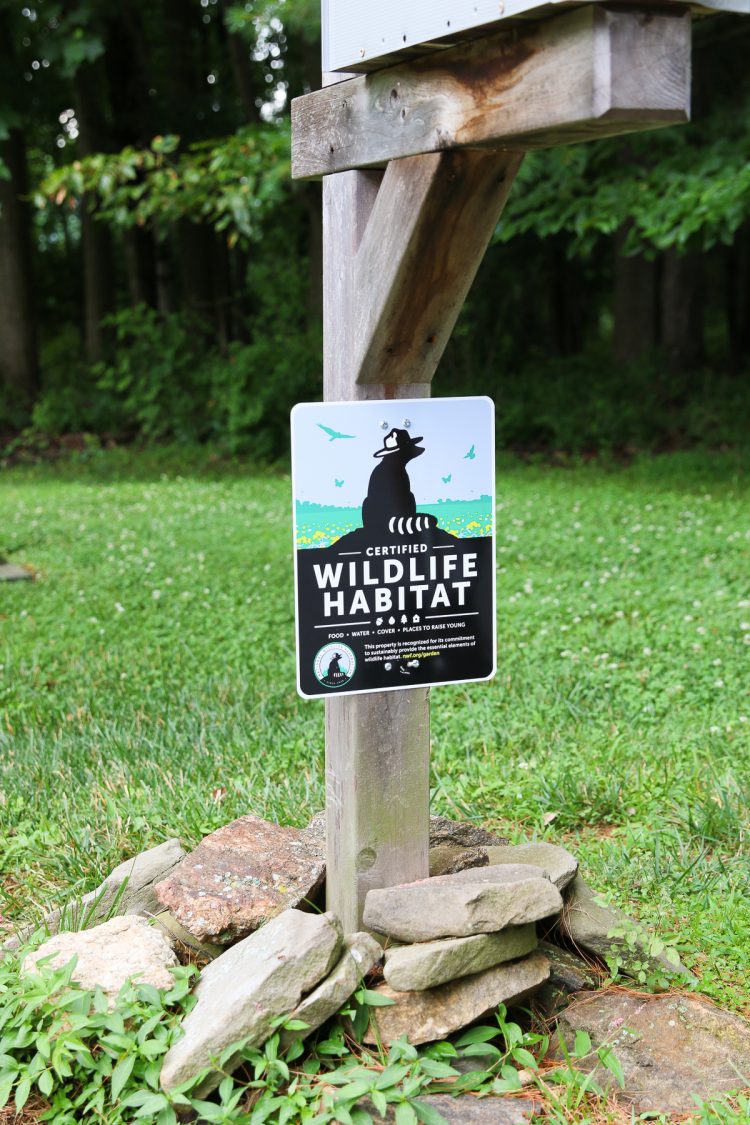
Water Conservation Methods
Speaking of water conservation, conserving water is an essential aspect of sustainable landscaping, especially if you live in an arid climate or one that is more apt to experience drought. Skip the investment in underground yard sprinkles and timers. You’re not going to coddle your grass anyway, remember?
If you do have a garden or landscaping that really needs watering, consider a drip irrigation system. This method of irrigation delivers water directly to the roots of plants, minimizing evaporation and promoting efficient water use. Additionally, incorporating a rain harvesting station, like a rain barrel or cistern, allows you to collect rainwater for your garden, reducing your reliance on municipal water sources.
If you like this post about sustainable home design, you might also like
Reusable Paper Towel Alternatives | Swedish Dishcloths vs. Reusable Cloth Rags
How To Stop Wasting Money and Energy on Phantom Power
5 Easy and Affordable Zero Waste Upgrades For Your Kitchen

Jen Panaro
Jen Panaro, founder and editor-in-chief of Honestly Modern, is a self-proclaimed composting nerd and advocate for sustainable living for modern families. To find her latest work, subscribe to her newsletter, Stepping Stones.
In her spare time, she’s a serial library book borrower, a messy gardener, and a mom of two boys who spends a lot of time in hockey rinks and on baseball fields.
You can find more of her work at Raising Global Kidizens, an online space to help parents and caregivers raise the next generation of responsible global citizens.



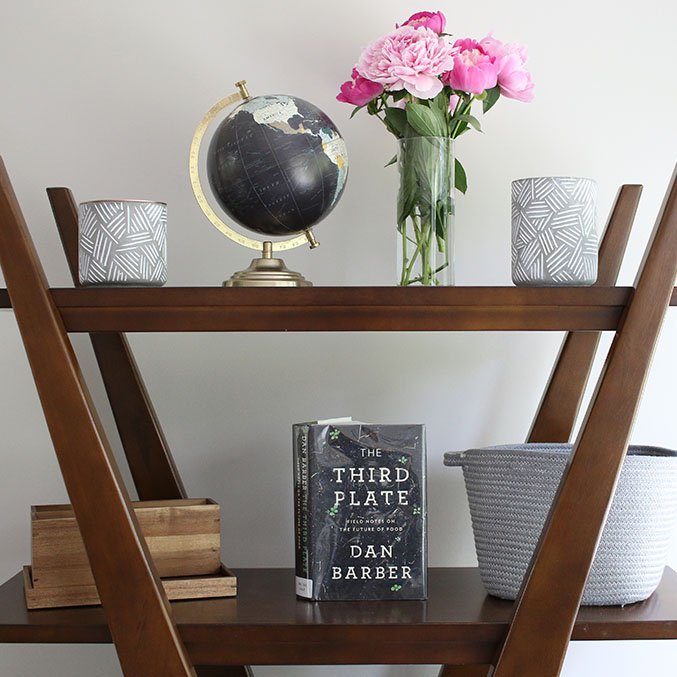
![12 Engaging Earth Day Activities and Event For Kids [2021]](https://www.honestlymodern.com/wp-content/uploads/2020/08/Hiking-With-Boys-How-To-Help-Kids-Explore-Nature-1.jpg)
